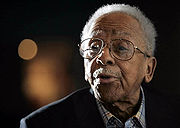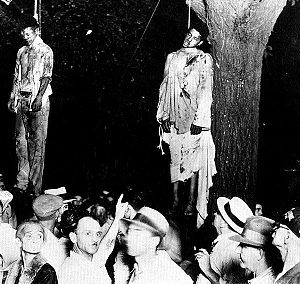
James Cameron (civil-rights activist)
Encyclopedia

James Cameron
James Francis Cameron is a Canadian-American film director, film producer, screenwriter, editor, environmentalist and inventor...
of the same name, was an American civil rights activist. In the 1940s, he founded three chapters of the National Association for the Advancement of Colored People
National Association for the Advancement of Colored People
The National Association for the Advancement of Colored People, usually abbreviated as NAACP, is an African-American civil rights organization in the United States, formed in 1909. Its mission is "to ensure the political, educational, social, and economic equality of rights of all persons and to...
(NAACP). He also served as Indiana's State Director of the Office of Civil Liberties for eight years during early integration. After moving to Wisconsin, in 1988 he founded America's Black Holocaust Museum
America's Black Holocaust Museum
America's Black Holocaust Museum located in Milwaukee, Wisconsin was the only memorial dedicated specifically to the victims of the enslavement of Africans in the United States...
in Milwaukee.
At his death, he was the only known survivor of a lynching
Lynching in the United States
Lynching, the practice of killing people by extrajudicial mob action, occurred in the United States chiefly from the late 18th century through the 1960s. Lynchings took place most frequently in the South from 1890 to the 1920s, with a peak in the annual toll in 1892.It is associated with...
attempt.
Early life and education
Cameron was born February 23, 1914 in La Crosse, WisconsinLa Crosse, Wisconsin
La Crosse is a city in and the county seat of La Crosse County, Wisconsin, United States. The city lies alongside the Mississippi River.The 2011 Census Bureau estimates the city had a population of 52,485...
to James Herbert Cameron and Vera Carter. After his father left the family, they moved to Birmingham, Alabama
Birmingham, Alabama
Birmingham is the largest city in Alabama. The city is the county seat of Jefferson County. According to the 2010 United States Census, Birmingham had a population of 212,237. The Birmingham-Hoover Metropolitan Area, in estimate by the U.S...
, then to Marion, Indiana
Marion, Indiana
Marion is a city in Grant County, Indiana, United States. The population was 29,948 as of the 2010 census. The city is the county seat of Grant County...
when James was 14 and his mother remarried.
Lynching attempt

Cameron and his two friends were taken from where they were being held in jail and lynched by a mob of 2,000-5,000 at the Grant County
Grant County, Indiana
Grant County is a county located in the U.S. state of Indiana. As of the 2010 census, the population was 70,061. The county seat is Marion. Important paleontological discoveries dating from the Pliocene epoch have been made at Pipe Creek Sinkhole in Grant County.-Geography:According to the 2010...
Courthouse Square. They were hanged from a tree on the square. Cameron witnessed the deaths of his friends but somehow was saved. In later years he said his neck was scarred from the rope. He heard someone saying he was not guilty, and was taken down before he died from hanging. No one from the mob was arrested or charged with the lynching of Cameron’s friends.
Cameron was convicted at trial in 1931 as an accessory to the murder of Deeter, and served four years of his sentence in a state prison. After Cameron was paroled, he moved to Detroit, Michigan
Detroit, Michigan
Detroit is the major city among the primary cultural, financial, and transportation centers in the Metro Detroit area, a region of 5.2 million people. As the seat of Wayne County, the city of Detroit is the largest city in the U.S. state of Michigan and serves as a major port on the Detroit River...
, where he worked at Stroh Brewery Company
Stroh Brewery Company
The Stroh Brewery Company was a beer brewery located in Detroit, Michigan. In addition to their own Stroh's brand, they produced or bought the rights to several other brands including Goebel, Schaefer, Schlitz, Augsburger, Erlanger, Lone Star, Old Milwaukee, Red River, and Signature, as well as...
and attended Wayne State University
Wayne State University
Wayne State University is a public research university located in Detroit, Michigan, United States, in the city's Midtown Cultural Center Historic District. Founded in 1868, WSU consists of 13 schools and colleges offering more than 400 major subject areas to over 32,000 graduate and...
.
Career
Cameron studied to become a boiler engineer and worked until he was 65. At the same time, he continued to study lynchings, race and civil rights in America and trying to teach others.Because of his personal experience, Cameron dedicated his life to promoting civil rights, racial unity and equality. While he worked in a variety of jobs, his civic commitment was shown by his founding three chapters of the National Association for the Advancement of Colored People
National Association for the Advancement of Colored People
The National Association for the Advancement of Colored People, usually abbreviated as NAACP, is an African-American civil rights organization in the United States, formed in 1909. Its mission is "to ensure the political, educational, social, and economic equality of rights of all persons and to...
(NAACP) during the 1940s — a time when the Ku Klux Klan
Ku Klux Klan
Ku Klux Klan, often abbreviated KKK and informally known as the Klan, is the name of three distinct past and present far-right organizations in the United States, which have advocated extremist reactionary currents such as white supremacy, white nationalism, and anti-immigration, historically...
was still active in the Midwest although its numbers had decreased since its peak in the 1920s. Cameron established and became the first president of the NAACP Madison County
Madison County, Indiana
As of the census of 2000, there were 133,358 people, 53,052 households, and 36,234 families residing in the county. The population density was 295 people per square mile . There were 56,939 housing units at an average density of 126 per square mile...
chapter in Anderson, Indiana
Anderson, Indiana
Anderson is a city in and the county seat of Madison County, Indiana, United States. It is the principal city of the Anderson, Indiana Metropolitan Statistical Area which encompasses Madison county. Anderson is the headquarters of the Church of God and home of Anderson University, which is...
.
Additionally, Cameron served as the Indiana State Director of Civil Liberties from 1942—1950. In this capacity, Cameron reported to Governor of Indiana Henry Schricker
Henry F. Schricker
Henry Frederick Schricker was the 36th and 38th Governor of the American state of Indiana from 1941 to 1945 and from 1949 to 1953. He is the only Indiana governor elected to two non-consecutive terms, and the only governor between 1852 and 1977 to be elected to more than one term in office...
on violations of the “equal accommodations” laws designed to end segregation. During his eight-year tenure, Cameron investigated more than 25 incidents of civil rights infractions. He faced violence and death threats because of his work.
Civic activism

Canada
Canada is a North American country consisting of ten provinces and three territories. Located in the northern part of the continent, it extends from the Atlantic Ocean in the east to the Pacific Ocean in the west, and northward into the Arctic Ocean...
, they decided on Milwaukee when he found work there. There Cameron continued his work in civil rights by assisting in protests to end segregated housing in the city. He also participated in both marches on Washington in the 1960s, the first with Dr. Martin Luther King, Jr.
Martin Luther King, Jr.
Martin Luther King, Jr. was an American clergyman, activist, and prominent leader in the African-American Civil Rights Movement. He is best known for being an iconic figure in the advancement of civil rights in the United States and around the world, using nonviolent methods following the...
, and the second with Dr. King’s widow Coretta and Rev. Jesse Jackson
Jesse Jackson
Jesse Louis Jackson, Sr. is an African-American civil rights activist and Baptist minister. He was a candidate for the Democratic presidential nomination in 1984 and 1988 and served as shadow senator for the District of Columbia from 1991 to 1997. He was the founder of both entities that merged to...
.
Cameron studied history on his own and lectured on the African-American experience. In 1982 he published his autobiography. From 1955 to 1989, Cameron published hundreds of articles and booklets detailing civil rights and occurrences of racial injustices, including "What is Equality in American Life?"; "The Lingering Problem of Reconstruction in American Life: Black Suffrage"; and "The Second Civil Rights Bill".
After being inspired by a visit with his wife to the Yad Vashem
Yad Vashem
Yad Vashem is Israel's official memorial to the Jewish victims of the Holocaust, established in 1953 through the Yad Vashem Law passed by the Knesset, Israel's parliament....
memorial in Israel
Israel
The State of Israel is a parliamentary republic located in the Middle East, along the eastern shore of the Mediterranean Sea...
, Cameron founded America's Black Holocaust Museum in 1988. He used material from his collections to document the struggles of African Americans in the United States, from slavery
Slavery
Slavery is a system under which people are treated as property to be bought and sold, and are forced to work. Slaves can be held against their will from the time of their capture, purchase or birth, and deprived of the right to leave, to refuse to work, or to demand compensation...
through lynchings, and civil rights. When he first started collecting materials about slavery, he kept it in his basement. He worked with others to build support for the museum. He was aided by philanthropist Daniel Bader.
His institution, America's Black Holocaust Museum, started as a grassroots effort. It is now one of the largest African-American museums in the country. In 2008, the museum's board of directors announced that the museum would be closed temporarily because of financial problems.
In 1991 Cameron was officially pardoned by the state of Indiana.
Marriage and family
He and his wife Virginia Hamilton had five children. At the time of his death, two sons, David and James, had died. He was survived by his wife Virginia and three children: Virgil, Walter and Dolores Cameron, plus numerous grandchildren and great-grandchildren.Death
Cameron died on June 11, 2006, at age 92 of congestive heart failure. He is buried at Holy Cross Cemetery in Milwaukee.Legacy and honors
- Wisconsin Public TV produced a documentary A Lynching in Marion.
- Marion, Indiana presented Cameron with a key to the city.
- Cameron was interviewed by BBC, and Dutch and German television.
- In 1999 Cameron was awarded an honorary doctorate by the University of Wisconsin-Milwaukee.
- Milwaukee added his name to four blocks of West North Avenue, from North King Drive to North 7th Street, in honor of James Cameron.
- America's Black Holocaust Museum has become a place of education and reconciliation.
Published works
- Cameron, James. A Time of Terror: A Survivor’s Story, self-published, 1982; reprinted Black Classics Press, 1994.
External links
- "Obituary of James Cameron", The Washington Post
- James Cameron's oral history video excerpts at The National Visionary Leadership Project
- David J. Marcou. "Challenger & Nurturer: Wisconsin Civil Rights Pioneer James Cameron (1914-2006)"

